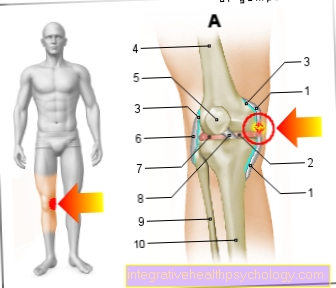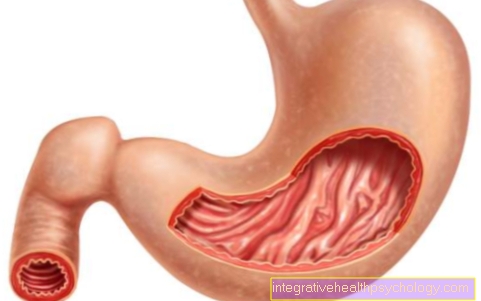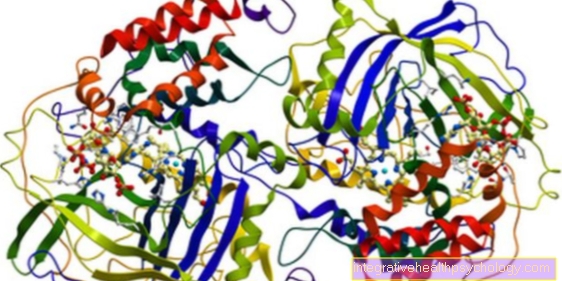Kidney cancer
All information given here is only of a general nature, tumor therapy always belongs in the hands of an experienced oncologist!
Synonyms
Medical: renal cell carcinoma, hypernephroma
Synonyms in the broader sense: kidney tumor, kidney carcinoma, kidney CA.
English: renal cancer, kidney cancer
definition
Almost all kidney tumors are so-called renal cell carcinomas. These malignant tumors (malignancies) are relatively insensitive to chemotherapy and can take very different courses. Kidney cancer is usually a tumor in the elderly (usually between 60 and 80 years of age).
Epidemiology
Every year between 8 and 20 people per 100,000 population develop kidney cancer (renal carcinoma). Men are affected twice as often as women.
causes
There are various risk factors known to promote kidney cancer (kidney CA).
Particularly noteworthy is tobacco consumption (especially in the case of inhalative smoking). Furthermore, overweight (obesity), kidney damage caused by analgesics (analgesic nephropathy), cystic kidneys, dialysis treatment, kidney transplantation and the contrast agent Thorotrast, which was previously used for X-ray examinations, seem to be related to the occurrence of the disease.
Most of the cases, however, are sporadic renal cell carcinomas, which must be distinguished from the hereditary familial forms.
Depending on the appearance under the microscope (histological), a distinction is made between five forms, depending on which kidney cells the tumor originated from:
- clear cell carcinoma (75%): exit from the lining tissue (epithelium) of the proximal tubule (see also the anatomy of the kidney)
- chromophilic carcinoma (15%): exit from the epithelium of the proximal tubule (often in several places and on both sides)
- chromophobic carcinoma (5%): exit from the distal tubular epithelium
- Oncocytic carcinoma (3%): exit from the collecting tube
- Bellini duct carcinoma (2%): exit from the collecting tube

Anatomy kidney
- Renal medulla
- Renal cortex
- Renal artery
- Renal vein
- Ureter
- Kidney capsule
- Calyx
- Renal pelvis

- Renal cortex - Renal cortex
- Renal medulla (formed by the
Kidney pyramids) -
Medulla renalis - Kidney bay (with filling fat) -
Renal sinus - Calyx - Calix renalis
- Renal pelvis - Pelvis renalis
- Ureter - Ureter
- Fiber capsule - Capsula fibrosa
- Kidney column - Columna renalis
- Renal artery - A. renalis
- Renal vein - V. renalis
- Renal papilla
(Tip of the kidney pyramid) -
Renal papilla - Adrenal gland -
Glandula suprarenalis - Fat capsule - Capsula adiposa
You can find an overview of all Dr-Gumpert images at: medical illustrations
Symptoms

Since kidney cancer often grows for a long time without causing symptoms, they often already have a diameter of more than 5 cm at the time of diagnosis and have already spread (metastasized) into the body in about 30% of patients, making the disease no longer curable. If signs of illness (symptoms) are expressed, they are:
- Blood in the urine (Hematuria) (at 40 - 60%)
- Flank pain (at 40%)
- palpable swelling (at 25-45%)
- Weight loss (at 30%)
- Anemia (Anemia) (at 30%)
- Fever (at 20%)
As "classic triad of symptoms " is a combination of the first three complaints. A number of side effects such as too many blood cells (polycythemia), too many calcium in the blood (hypercalcaemia) and impairment of liver function (Stauffer syndrome) are known.
Other complaints are caused by the local growth of the tumor, e.g. B. penetration into the lower Vena cava (Vena cava inferior) with education more dangerous Blood clot (thrombosis), or in metastasis (complaints caused by daughter tumors in other tissues, e.g. Back pain with a daughter tumor in the Spine with possibly Vertebral fracture).
The daughter tumors (metastases) are preferably located in Lungs, Lymph nodes, liver and skeleton.
Are rarer Adrenal glands, the other kidney or that brain infested. Most affected patients already have daughter tumors in several organs when the underlying disease is recognized (diagnosis).
Diagnosis and classification
Inevitable for the detection and staging of kidney cancer are the physical (clinical) examination, Ultrasound (sonography), excretory urography (assesses the urine output) and Computed Tomography (CT).
There are two common staging that TMN system and the Classification according to Robson. Both are based on the extent of the original tumor (primary tumor), lymph node or distant metastases, as well as the differentiation of the tissue (i.e. if the original tissue of the tumor can still be identified). The staging influences the further therapy and the prognosis of the patient.
TMN classification according to UICC / WHO (1997)
- T - primary tumor:
T1 (tumor limited to kidney, <7cm)
T2 (tumor limited to kidney,> 7cm)
T3 (venous or adrenal infiltration; details: a, b, c)
T4 (infiltration beyond the Gerota fascia)
- N - Regional lymph nodes:
N0 (not infested)
N1 (solitary, regional)
N2 (> 1 regional LK)
N3 (multiple infestation,> 5cm)
- M - distant metastases:
M0 (no distant metastases)
M1 (distant metastases; organ code)
Before an operation, there are optionally an angiography (vascular representation of the arteries), a cavography (one looks at the inferior vena cava) and a MRI of the abdomen added.
To search for metastases, a X-ray of Thorax (rib cage) in two planes, CT of the lungs, or a skeletal scintigram (accumulation of radioactive substances in tumor tissue).
Differential diagnoses
It can also Kidney cysts be responsible for the above complaints.
This can be done with imaging techniques such as:
- Sonography (ultrasound)
- CT (computed tomography)
- MRI (magnetic resonance imaging of the abdomen)
clarify.
You can also find more information about kidney cysts at:
Kidney cysts
Therapy and Prevention
The following help prevent renal cell carcinoma:
- Quit smoking
- Avoiding certain groups of painkillers (e.g. painkillers containing phenacetin, e.g. paracetamol)
- Weight loss
- Preventive examinations for patients with severe kidney weakness / kidney failure (terminal kidney failure), cystic kidneys, von Hippel-Lindau syndrome, tuberous sclerosis
In the case of renal cell carcinoma / kidney cancer that has not yet spread, surgical removal of the tumor (radical tumor nephrectomy) together with the kidney, adrenal gland and adjacent lymph nodes is sought as standard therapy. If necessary, affected parts of the vessel are removed and provided with a vascular prosthesis (replacement piece for vessel incisions).
The operation also has advantages for existing daughter tumors: so-called paraneoplastic symptoms (signs of disease that are not directly caused by the tumor or its daughter tumors, but are related to the occurrence of the tumor; e.g. increased sedimentation rate 56%, anemia 36%), as well as tumor-related pain and bleeding are reduced. Individual metastases can also be removed. In patients who only have one kidney from the start, this is only partially removed.
A local recurrence, i.e. H. a new tumor in the same place is removed again as far as possible.
The benefit of adjuvant therapy (subsequent chemotherapy, hormone therapy, radiation therapy, etc.) has not been proven. Interventions that aim not to cure the symptoms but to alleviate the symptoms (palliative interventions) are removal of metastases from the lungs, brain and bones.
Renal cell carcinomas are unresponsive to radiation or chemotherapy.
Note treatment
New treatment approaches with "biological response modifiers“Are promising.
A more recent development is the use of so-called "biological response modifiers", which intervene in the patient's immune system in order to treat the tumor.
There are messenger substances of the Immune system (Interleukin-2, tumor necrosis factors) are used, which restrict the growth of tumor cells and mark them as a target for cell-killing (cytotoxic) T lymphocytes and macrophages (the body's own defense cells). This white blood cells (Leukocytes) ensure that the tumor cells destroy themselves (apoptosis) or actively participate in the destruction (e.g. through phagocytosis).
The positive effects but are usually quite short and usually do not outweigh the observed side effects. They can be suitable for palliative treatment.
Complications
They are caused by the local growth of the tumor or the respective metastases, e.g. B.
- thrombosis
- Pulmonary embolism
- Vertebral fracture
- high blood pressure
- and much more.
forecast
The to survive the patient depends primarily on the tumor stage. 60 - 90% of patients in stage I survive at least 5 years, but only less than 20% in stage IV.
A low degree of differentiation of the tumor tissue (i.e.: you can still see under the microscope which type of tissue is degenerate) and a poor general condition of the patient also have an unfavorable effect on the prognosis.
However, there are repeated reports of patients who have recovered spontaneously (spontaneous remission) or in whom the disease has remained stable for years.
An influence of the patient's own immune system is suspected here, which has led to and will presumably lead to many treatment approaches that are based on these immunological effects.





























